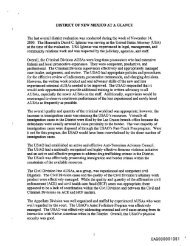The 2003 Index of Hospital Quality
The 2003 Index of Hospital Quality
The 2003 Index of Hospital Quality
You also want an ePaper? Increase the reach of your titles
YUMPU automatically turns print PDFs into web optimized ePapers that Google loves.
I Introduction<br />
Health care providers and consumers today face a dynamic and <strong>of</strong>ten puzzling array <strong>of</strong><br />
choices with few tools to inform their critical decisions about quality <strong>of</strong> care. No single<br />
standard measure <strong>of</strong> quality <strong>of</strong> care is available for the 6,003 hospitals in the United States.<br />
In 1993, the National Opinion Research Center at the University <strong>of</strong> Chicago (NORC)<br />
developed such a measure. This “report card” is supported and published annually by U.S.<br />
News & World Report in an issue entitled “America’s Best <strong>Hospital</strong>s” that identifies centers<br />
<strong>of</strong> exceptional capability in 17 medical specialties.<br />
In the NORC report card, each hospital receives a score called the <strong>Index</strong> <strong>of</strong> <strong>Hospital</strong> <strong>Quality</strong><br />
(IHQ), which assesses hospital quality by taking into account the three fundamental<br />
dimensions <strong>of</strong> health care delivery: structure, process, and outcome (the Donabedian<br />
paradigm 1,2 ). None <strong>of</strong> these dimensions alone can completely and accurately represent<br />
quality <strong>of</strong> care; all three must be combined to produce a comprehensive measure. Care<br />
starts with the structural characteristics <strong>of</strong> an institution (such as the number <strong>of</strong> patients<br />
served and the range <strong>of</strong> medical technology available), moves through the process <strong>of</strong><br />
delivering care, and produces results, or outcomes, for the patients served. To be most<br />
useful to the consumer and provider <strong>of</strong> care, the IHQ combines robust and sensitive<br />
measures <strong>of</strong> each <strong>of</strong> these dimensions for the universe <strong>of</strong> hospitals across a wide range <strong>of</strong><br />
medical and surgical practice specialties. <strong>The</strong> IHQ draws from secondary sources, such<br />
as the American <strong>Hospital</strong> Association (AHA) Annual Survey <strong>of</strong> <strong>Hospital</strong>s, for data<br />
concerning various quality dimensions. We continually try to improve the specificity and<br />
sensitivity <strong>of</strong> the measures we use to rank hospitals and to identify the best possible<br />
sources <strong>of</strong> data.<br />
<strong>The</strong> following sections define the universe <strong>of</strong> hospitals for the purpose <strong>of</strong> this project,<br />
describe and define the standardized mortality ratios and the structural components, and<br />
explain how process-related data are collected. A description <strong>of</strong> changes made for the<br />
<strong>2003</strong> IHQ is also provided. A short description <strong>of</strong> each <strong>of</strong> the component <strong>of</strong> the index is<br />
provided below:<br />
1












